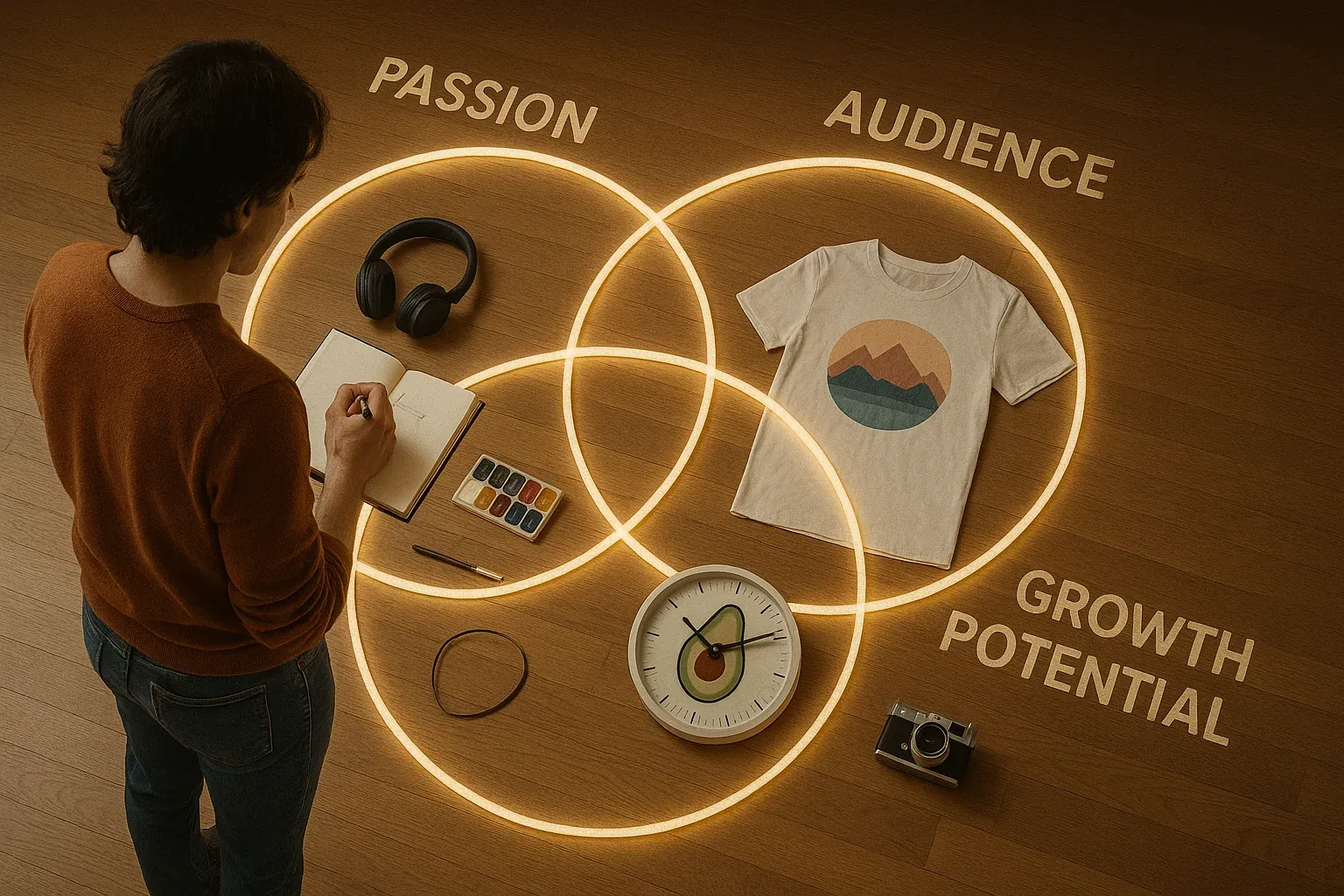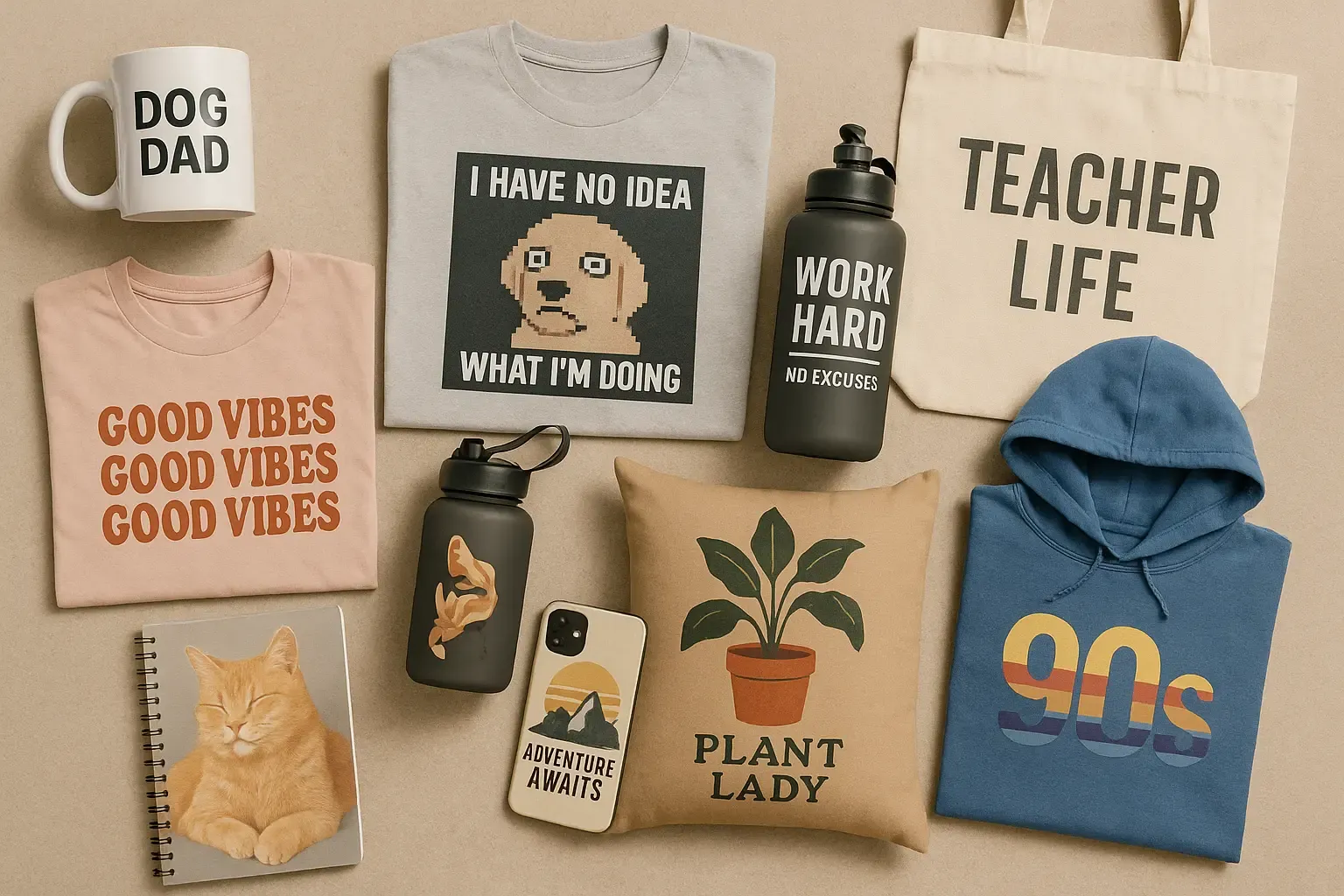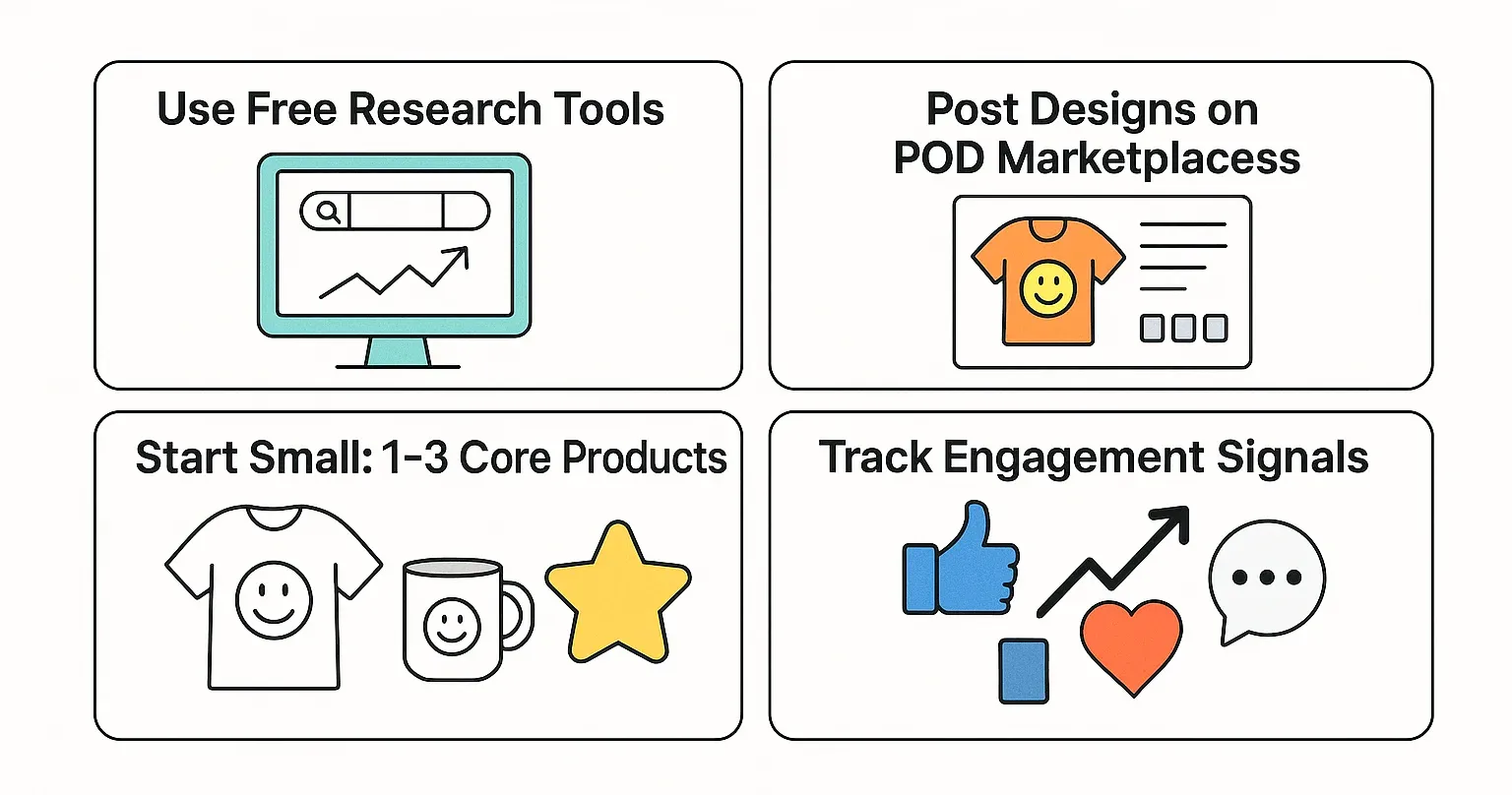Which Niche Is Best for Print-on-Demand? Find Your Perfect Fit Today

The best niches for print-on-demand are specific, passion-driven communities—like pet lovers, nurses, or gamers. These groups are more likely to buy products that reflect who they are.
In print-on-demand (POD), your niche defines who you’re creating for. The more focused your audience, the easier it is to stand out and make consistent sales. That’s why choosing the right niche is one of the most important steps when starting out.
Here’s what makes a niche “good” for POD:
- Emotional connection – People buy things that reflect their identity
- Clear audience – You know exactly who you're talking to
- Gift potential – Great niches often work well for birthdays, holidays, or life events
- Low-to-medium competition – Easier to get noticed without a big brand or following
In this guide, you’ll learn how to pick the right niche and see examples of top-selling POD categories in 2025.
Key Takeaways:
- Print-on-demand works best when your products connect to specific passions—like pets, gaming, or professions. People buy what reflects their identity, not just another mug or T-shirt.
- If you understand your niche well, you can create designs that feel personal. This leads to stronger marketing, more loyal buyers, and higher chances of repeat sales.
- Pick one niche you care about—ideally with an active online community and gift-buying potential. Launch with just a few product types. As you get sales, use real customer data to decide where to expand next.
What Is a Niche in Print-on-Demand?
A niche in print-on-demand is a specific group of people united by a common interest, identity, or lifestyle—like cat lovers, gym enthusiasts, or new dads who fish. It defines who your designs are for and helps you speak directly to their interests.
Focusing on a niche makes your products more relevant and appealing. Instead of trying to sell “funny shirts” to everyone, you’re selling “funny shirts for cat moms who drink wine.” That’s more personal—and way more effective.
Why niches work in POD:
- You can create highly relevant, emotionally resonant designs
- Your audience feels like the product was made for them
- It’s easier to build brand loyalty and stand out from competitors
Think of it like fishing: use the right bait in the right spot, and you won’t just get more bites—you’ll catch the right fish.
Why Choosing the Right Niche Matters?
Choosing the right niche helps you sell smarter, not harder. When you speak to a focused audience, you lower your competition and increase your connection.
Here’s why it matters:
- Less competition: Niche products don’t fight for space with mass-market items.
- More targeted marketing: You know exactly who you’re talking to—what they love, laugh at, and click on.
- Loyal fans: When people feel understood, they stick around. That means more repeat sales and word-of-mouth referrals.
The bottom line? Broad is forgettable. Niche is memorable—and profitable.
Now that you know how important the niche in POD is, pairing this with a good platform will give you a good start. Here is our comprehensive guide about: "Best Print-on-Demand Platform"
How to Choose the Best POD Niche for You?

The best print-on-demand niche for you is one that overlaps with your interests, serves a passionate audience, and gives you room to grow. You don’t need to chase every trend—just focus on connecting with people who care about what you’re offering.
When you find the right niche, your designs resonate, your marketing clicks, and sales come more naturally.
Here’s how to discover that sweet spot:
1. Consider Your Interests or Experience
Start with what you already know and enjoy. If you're into fitness, gaming, fishing, or reading, chances are there’s a niche audience who shares that passion.
Why it matters:
- You understand the language, humor, and lifestyle of the niche
- Designing becomes easier and more authentic
- You’re more likely to stick with it long term
People can tell when a product comes from someone in the know—and they buy into that.
2. Look for Passionate or Underserved Communities
The best niches are full of people who really care—and who want to express it through what they buy. Communities like:
- Nurses
- Cat owners
- Plant moms
- Gamers
- Teachers
Even better? Some of these groups are underserved. That means fewer competitors and more loyal fans waiting to find someone like you.
3. Use Research Tools to Spot Trends
Don’t rely on gut instinct—use tools to find what’s trending.
Start with:
- Google Trends: See if interest is rising or falling
- TikTok Search: Spot viral products and niche hashtags
- Pinterest & Etsy: Explore trending designs and seasonal demand
👉 Want a deeper dive? Check out this guide to selling POD on Amazon using data-backed strategies.
4. Think About Product Types That Fit the Niche
Different niches naturally align with different products.
Examples:
- Teachers: Mugs, posters, tote bags
- Campers & hikers: T-shirts, hats, water bottles
- Pet lovers: Custom pet mugs, breed-specific hoodies
Think about what people in your niche actually use or gift—and design accordingly.
5. Keep It Simple: Start Narrow and Expand Later
Start small. Focus on one niche and a few well-chosen products. That’s how you learn what resonates without getting overwhelmed.
Once you get traction, then you can:
- Expand into related sub-niches
- Add more product types
- Scale with data, not guesses
Bottom line: Depth beats breadth when you’re starting out. Niche down first—then build out.
Top 10 Best Print-on-Demand Niches in 2025

The best niches for print-on-demand in 2025 are tied to identity, emotion, and lifestyle. These are topics people care about deeply—so they’re more likely to buy products that reflect them.
Whether it’s a joke that feels personal or a gift that celebrates a life milestone, these niches are proven to convert.
Here are 10 of the strongest print-on-demand niches right now—plus examples of what sells in each:
1. Animals & Pets
Why it works: Pet lovers are loyal, emotional buyers who treat their animals like family.
What to sell:
- Breed-specific shirts
- Custom pet mugs
- “Dog dad” or “cat mom” merch
Pet-themed products also make perfect gifts—both for others and for themselves.
2. Humor & Memes
Why it works: People love to laugh—and to share what makes them laugh.
What to sell:
- Meme t-shirts
- Viral mugs
- Sarcastic or niche humor prints
If you can stay ahead of trends or create evergreen jokes, this niche has high viral potential.
3. Job-Related Niches
Why it works: People are proud of their profession and love when it’s recognized.
What to sell:
- Nurse mugs
- Teacher tote bags
- Funny or heartfelt job-specific shirts
These are perfect for gift-giving holidays like Teacher Appreciation Week or Nurses Week—and they’re great for sub-niching (like “funny shirts for HVAC techs”).
4. Health & Fitness
Why it works: Fitness is both a mindset and a lifestyle, and people love to wear it.
What to sell:
- Workout shirts
- Gym water bottles
- Motivational hoodies
This audience is motivated, often aspirational, and always looking for gear that reflects their goals.
5. Travel & Outdoors
Why it works: Adventure lovers identify deeply with the outdoors and want merch to match.
What to sell:
- Camping hoodies
- Hiking hats
- Van life or road trip tees
Think rugged, inspirational, or nature-themed designs that speak to wanderlust.
6. Life Milestones & Events
Why it works: People are always shopping for meaningful gifts to mark big moments.
What to sell:
- Wedding mugs
- Graduation posters
- Birthday shirts
Milestone-related niches spike around events and holidays—and they’re perfect for personalization.
7. Music
Why it works: Music fans form deep bonds with genres, lyrics, and artists.
What to sell:
- Lyric prints
- Genre-themed tees
- Music lover mugs
Be sure to use original or royalty-free designs to avoid copyright issues.
8. Vintage & Retro
Why it works: Nostalgia is a powerful emotion—and a strong selling point.
What to sell:
- ‘90s-style t-shirts
- Retro phone cases
- Vintage-inspired poster sets
People love designs that remind them of a favorite era, whether it's the ‘80s, ‘70s, or early 2000s.
9. Mental Health
Why it works: Positivity, emotional wellness, and mental health awareness are more popular (and important) than ever.
What to sell:
- Affirmation journals
- Mental health mugs
- Self-care quote shirts
Products in this niche should feel encouraging, kind, and authentic—not preachy.
10. Hobbies
Why it works: People spend more on things tied to what they love doing.
What to sell:
- Gaming t-shirts
- Cooking aprons
- Knitting tote bags
The more specific the hobby, the more loyal and excited the customer.
Bonus: Want more inspiration? Explore trending POD products for 2025 to find designs that are already gaining traction.
Niche Comparison Table
Which print-on-demand niche is best for beginners or fast growth?
It depends on your goals. Some niches are low-competition and easy to enter, while others are larger or trendier but require faster adaptation and deeper marketing.
To help you choose wisely, this table compares the top 10 POD niches by five key factors:
- Audience Size – how big or active the buying community is
- Trend Strength – how much interest is growing or declining
- Customization Potential – how easily designs can be personalized
- Competition Level – how saturated the niche is
- Product Variety – how many different POD items fit the niche
🔍 Quick Niche Comparison Chart (2025)
| Niche | Audience Size | Trend Strength | Customization | Competition | Best Products |
|---|---|---|---|---|---|
| Animals & Pets | Very High | Evergreen | High | Medium | Mugs, shirts, blankets |
| Humor & Memes | High | Fast-moving | Medium | High | Shirts, mugs, posters |
| Job-Related | High | Evergreen | Med–High | Medium | Mugs, totes, journals |
| Health & Fitness | Med–High | Steady | Medium | Med–High | Shirts, water bottles |
| Travel & Outdoors | Medium | Evergreen | Medium | Medium | Hoodies, caps, stickers |
| Life Milestones | High | Seasonal + Evergreen | High | Medium | Posters, mugs, cards |
| Music | High | Steady | Medium | High | Shirts, prints, stickers |
| Vintage & Retro | High | Trendy | Medium | High | Tees, posters, accessories |
| Mental Health | Medium | Rising | High | Low–Medium | Journals, mugs, shirts |
| Hobbies | Med–High | Niche-driven | Medium | Low–Medium | Shirts, aprons, mugs |
How to Use This Table?
💡 If you’re new to POD:
Start with low-competition, high-passion niches like:
- Mental health
- Specific hobbies (e.g., baking, gaming, fishing)
⚡ If you want to follow fast trends:
Try humor and memes—but be ready to keep up with what’s current.
🎁 If you’re focused on gifting or long-term sales:
Stick to job-related, pet, or life milestone niches. They’re steady, evergreen, and highly giftable.
Final tip: Don’t pick a niche just because the table says it’s big or growing. Choose one you can connect with, market to, and create for. That’s how you build a brand that lasts.
How Do You Test and Validate a Print-on-Demand Niche?

Before committing to a niche, test it with real data and simple experiments. This helps you avoid investing time and money into designs that won’t sell.
Here are four practical ways to validate your POD niche before going all-in:
1. Use Free Research Tools
Get early signals from platforms your audience already uses. These tools help you spot trends, demand, and buyer intent:
- Google Trends – Check if interest in your niche is rising or falling
- Etsy Search – Explore popular products and see what’s getting reviews
- TikTok Search – Find trending content and what creators are talking about
🔍 Example: If “funny cat mugs” show growing interest on Google Trends and Etsy listings are selling well, that’s a strong green light.
2. Post Designs on POD Marketplaces
Upload your test designs to platforms like:
- Redbubble
- TeePublic
- Etsy
These platforms don’t require upfront costs and allow you to see what gains traction. Use clear, keyword-rich titles and tags so your items are discoverable.
📌 You’re not just testing your design—you’re testing your audience’s response to your niche.
3. Start Small: 1–3 Core Products
Instead of launching a full product line, start with a tight set:
- 1 t-shirt
- 1 mug
- 1 sticker or journal
This makes it easier to manage listings, track results, and identify winners early on.
4. Track Engagement Signals
Before sales come in, look for signs that your niche is resonating. On social media and marketplaces, pay attention to:
- Likes and shares
- Saves and comments
- Click-throughs or shop visits
📈 Engagement shows interest. Interest leads to sales.
Bottom line: A niche isn’t “validated” by a good idea—it’s validated by real-world interest. Use these low-risk methods to gather data before you scale.
What Are the Most Common Mistakes When Picking a POD Niche?
Choosing the wrong niche is one of the fastest ways to stall your print-on-demand success. Many beginners fall into the same traps—going too broad, copying trends, or ignoring buyer behavior.
Here’s what to watch out for:
1. Going Too Broad
A vague niche = a forgettable product.
Trying to target “everyone” only waters down your message.
✅ Better approach: Focus on a clear subgroup.
- ❌ Too broad: “Fitness shirts”
- ✅ Stronger: “Funny gym shirts for women who lift”
Starting small helps you connect, convert, and eventually grow.
2. Chasing Trends Without Understanding Them
Just because it’s trending doesn’t mean it’s right for you.
Jumping on a meme or niche you don’t understand can lead to weak designs or awkward messaging.
🔥 Trends fade. Build around passions that last.
3. Copying Without Creativity
Copying popular products isn’t a plan—it’s a shortcut to saturation.
Instead of cloning, remix:
- Combine two ideas
- Aim at a specific sub-audience
- Add a voice or angle that feels original
💡 Example: Don’t just make another “dog dad” shirt—make one for “introverted dog dads who love gardening.”
4. Ignoring Timing or Buyer Intent
Products don’t sell if you launch them at the wrong time.
Know when your target audience is buying. Many niches are tied to seasons, holidays, or life events.
📆 Example:
- Graduation gear → April–June
- Teacher gifts → August–December
- Wedding merch → Spring and summer
Match your launch to real-world demand.
Avoid these four mistakes, and you’ll be ahead of most new sellers. Next, we’ll explore how to find the right niche for you—and why changing directions later is totally okay.
Final Thoughts: What’s the Best Niche for You?

The best niche for you is one that matches your interests, has real demand, and gives you room to offer something unique.
There’s no single “best” niche for everyone—but there is a right one for you.
Here’s what a great POD niche looks like:
- You're genuinely curious or connected to the topic
- There's clear demand (people are buying)
- You can spot what’s missing—or how to improve what’s out there
Start Small. Test Smart.
You don’t need to launch with a full store. Instead:
- Pick one niche
- Launch 2–3 core products (like a shirt, mug, or journal)
- Watch what gets clicks, saves, or sales
This lets you build confidence and traction without feeling overwhelmed.
It’s Okay to Pivot
Your first niche might flop—and that’s fine.
Failure isn't the end. It's feedback.
Each design, comment, and view helps you figure out what works. The most successful sellers keep learning and adjusting.
Up next: We’ll answer the most common beginner questions—like how to deal with competition, whether you can mix niches, and when it’s time to switch directions. Let’s dive in.
Frequently Asked Questions

1. What’s the easiest niche to start with in POD?
The easiest niche is one you already know or care about.
If you're into fitness, pets, or gaming, you'll have an edge—you understand the audience, the humor, and what products they'd actually buy.
2. What niche makes the most money in print-on-demand?
Niches tied to identity and emotion earn the most.
Top earners include pet lovers, healthcare workers, teachers, and fitness fans. These buyers love showing who they are and often shop for themselves and others.
3. Can I combine two niches?
Yes—combining niches (aka niche stacking) can help you stand out.
For example, funny dog owner shirts or yoga-themed teacher mugs. Just make sure both parts connect with a real, passionate audience.
4. How do I know if a niche is too competitive?
If search results are filled with similar designs, it’s likely saturated.
Check platforms like Etsy or Amazon. If you see the same slogans, styles, and prices over and over, try narrowing your niche or adding a unique twist.
5. Should I follow trends or stick with evergreen niches?
Both are useful—but don’t rely only on trends.
Evergreen niches (like pets or professions) give steady sales. Trends can bring quick spikes. A healthy mix works best.
6. What are low-competition niches in 2025?
Emerging or underserved communities are your best bet.
In 2025, look at areas like mindful parenting, eco-friendly hobbies, niche music scenes, or indie game fandoms. They’re growing—but not yet crowded.
7. How many niches should I try at once?
Start with one niche, test it, then expand.
Trying too many at once waters down your effort. Focus on one audience, learn what works, then branch out based on what you’ve learned.
8. What if my niche doesn’t sell at first?
Don’t panic—analyze and adjust.
It might be the design, not the niche. Try better keywords, improve your product mockups, or shift your messaging. Early data is valuable—use it.
9. Can I change my niche later?
Yes—many successful sellers pivot.
If your first niche flops or no longer fits, you can always switch. Just be clear about your branding, and consider a new store if the new niche is totally different.
10. Do I need a big following to succeed?
No—you just need the right people to see your products.
You can grow through SEO, marketplaces like Etsy, or by posting in niche communities. A loyal niche audience beats a big, random one every time.
Ready to Turn Your Niche Idea into a Real POD Business?
Join our mini-course at WAH Academy and get step-by-step help to launch your print-on-demand store—without the stress or overwhelm.
No fluff. No hassle. Just real moves to get your business off the ground.
Tap the button and start building your POD brand today.
